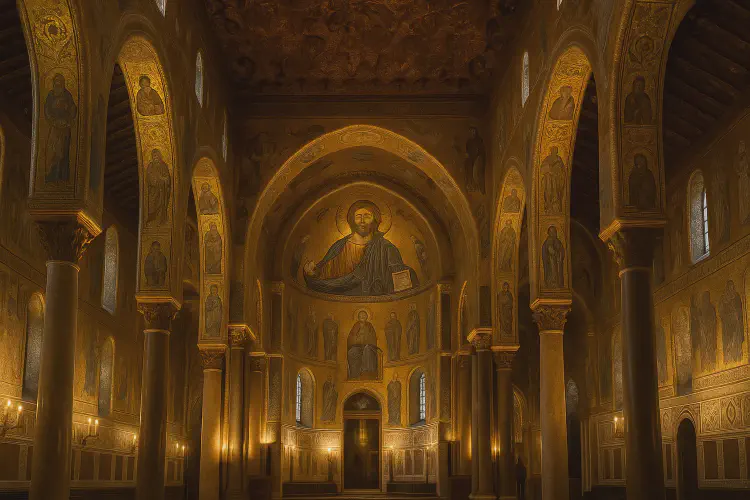Arab Norman architecture in Sicily
Between the 9th and 12th centuries, Sicily became a melting pot of **Arab, Norman, and Byzantine influences**. The result was a unique artistic style known as **Arab-Norman architecture** — a harmonious fusion of Islamic geometry, Latin structural design, and Byzantine mosaics that flourished under Norman rule.
- Visit Sicily
- 3 min read

Arab-Norman Architecture in Sicily — A Cultural Fusion
🏰 Overview
Sicily’s Arab-Norman architectural heritage stands as one of the most remarkable examples of cultural coexistence in medieval Europe. After the Arab conquest in the 9th century, Islamic builders introduced advanced engineering, decorative arts, and urban planning. When the Normans arrived in the 11th century, they preserved and blended these Arabic techniques with their own Romanesque style and the shimmering mosaics of Byzantine artists.
The result was a distinctive Sicilian style, visible in palaces, churches, and cathedrals — so unique that UNESCO declared the Arab-Norman Palermo and the Cathedrals of Cefalù and Monreale a World Heritage Site in 2015.
🕌 Key Arab-Norman Monuments in Sicily
1. Palatine Chapel (Cappella Palatina), Palermo
Built in the 12th century by King Roger II inside the Norman Palace, the Palatine Chapel perfectly embodies Arab-Norman harmony:
- Byzantine mosaics depicting biblical scenes in gold.
- Muqarnas ceiling — a carved wooden honeycomb pattern typical of Islamic art.
- Arabic inscriptions praising God alongside Latin ones — a symbol of peaceful coexistence.
2. Monreale Cathedral
Located just outside Palermo, this 12th-century cathedral is the culmination of Arab-Norman art:
- Covered in 6,000 m² of golden mosaics, including the iconic Christ Pantocrator.
- Features Arab-style geometric motifs and a cloister with twin columns carved in marble and mosaic.
- Its architecture reflects Norman grandeur, Byzantine spirituality, and Arab craftsmanship.
3. Cefalù Cathedral
Commissioned by Roger II as a royal vow of gratitude, Cefalù Cathedral overlooks the sea with a majestic two-tower façade.
- The interior’s mosaics, especially the Christ Pantocrator, rival those of Monreale.
- Its fortress-like exterior shows Norman engineering, while the interior glows with Byzantine beauty.
4. San Giovanni degli Eremiti, Palermo
Known for its red domes, this church blends Islamic and Christian architecture — originally a mosque, later converted into a Benedictine monastery.
- The domes and arches echo North African design.
- The gardens retain the atmosphere of an Arabic courtyard.
5. La Martorana (Santa Maria dell’Ammiraglio)
A 12th-century church famous for its golden mosaics and Arabic-style arches.
- Byzantine mosaic icons blend with Kufic-style inscriptions.
- Symbolizes Palermo’s multicultural identity in the Norman era.
6. Cuba Palace and Zisa Palace, Palermo
Secular Arab-Norman buildings used as royal summer residences.
- Designed with Arabic cooling systems and gardens inspired by Islamic paradise imagery.
- The Zisa Palace now houses a museum of Islamic art.
🧭 The Cultural Significance
Arab-Norman architecture is more than just an artistic style — it’s a testament to cultural tolerance and innovation. Under Norman rule, Muslims, Christians, and Jews coexisted and collaborated, creating an aesthetic that celebrated diversity rather than division.
This fusion made 12th-century Palermo one of the most advanced cities in Europe, admired for its learning, trade, and art.
🌍 UNESCO Recognition
The following sites are listed as part of the UNESCO World Heritage Site “Arab-Norman Palermo and the Cathedrals of Cefalù and Monreale”:
- Royal Palace and Palatine Chapel (Palermo)
- Zisa Palace (Palermo)
- Martorana and San Cataldo churches (Palermo)
- Palermo Cathedral
- Monreale Cathedral
- Cefalù Cathedral
🧭 Summary
Sicily’s Arab-Norman architecture reflects an era when cultures met and enriched one another. The blend of Norman strength, Arab elegance, and Byzantine spirituality produced a visual language unlike anything else in Europe. Walking through Palermo, Monreale, or Cefalù today, you can still feel the harmony of that golden age — a shining symbol of Sicily’s enduring role as a crossroads of civilizations.